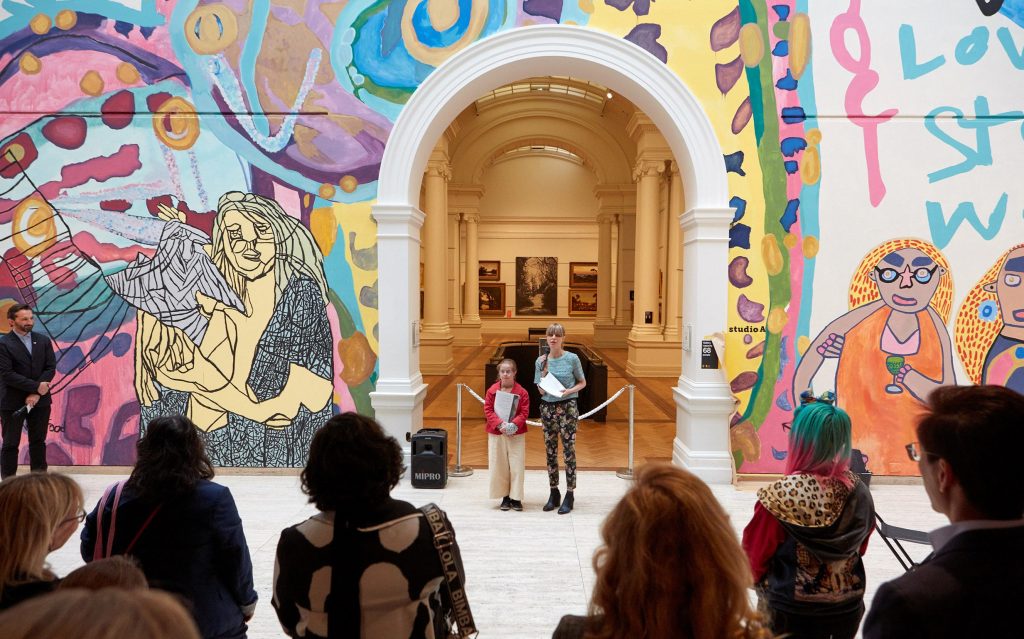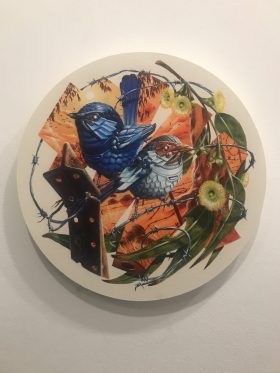Based in Sydney, Studio A is an enterprise which supports artists with intellectual disabilities and tackles the barriers they face in pursuing a career in the visual arts. As CEO and Artistic Director, Gabrielle Mordy is a strong advocate for these artists, where her everyday job includes everything from curating to delivering presentations to corporate supporters.
A practising artist herself, Mordy is a firm believer in the power of art to translate experiences across cultures. With a background in Fine Arts and Anthropology, she was awarded the Churchill Scholarship and an Australia Council Career Development Award to undertake international research into the supported studio sector in 2014.
Prior to Studio A, Mordy was the Artistic Director of Studio ARTES Northside for 10 years (which she began through volunteering), offering full time arts programs to adults with disabilities.
During her tenure at Studio ARTES, she implemented professional development programs for artists with disabilities to create a foreseeable career pathway, created networking opportunities to heighten the exposure of their works to institutions and professionals, as well as successfully receiving over $160,000 in grants over four years.
Mordy shared with ArtsHub how Studio A was formed in 2016, the breadth of talent that artists with disabilities offers and why a touch of humour is vital to work in the sector.
How would you describe what you do?
I support artists with intellectual disability to have a professional career as an artist. I am the CEO and Artistic Director of Studio A, where I currently support eighteen artists with disability.
How did you get started in your career?
Quite by accident. I studied Visual Arts and Anthropology at university. One day I quite randomly offered to volunteer in an arts program for adults with disability called Studio ARTES. On my first day of volunteering I was immediately entranced. I loved the art being produced and the sense of community.
This experience inspired me to complete my Honours degree in Anthropology where I wrote about the culture of art and disability.
Between my study and my work at Studio ARTES I could see this pool of artists with intellectual disability who had huge talent and drive, but who were equally locked out of accessing the benefits of the professional art world. When you struggle with skills like literacy, transport and using technology, it becomes pretty tough to pursue a professional art career.
Motivated by this need I developed a range of smaller scale projects that supported the professional development of artists with intellectual disability and this work eventually grew into creating the company Studio A.
What’s an average day or week like?
My average week includes a huge variety. It can range from writing a demanding funding grant, to supporting a Studio A artist to develop new work, to curating an exhibition with a gallery.
At times I am presenting in Sydney’s CBD to corporate supporters and in another week I am in a regional art residency with Studio A artists. I really enjoy the variety.
Concurrently with these activities I work closely with Studio A’s board and team of staff to ensure Studio A’s is using all its resources effectively to meet our mission.
What’s the most common misconception about working with artists with intellectual disabilities?
That Studio A is an art therapy centre. When people hear I work with artists with intellectual disability this is a very common assumption – that I am a therapist.
I think this reflects a broader entrenched mindset in our community that if you have a disability everything you do must be about ‘fixing’ or remedying yourself. That you cannot simply be a professional who is really skilled at something.
There is a misconception that the art produced by artists with intellectual disability will not be very high quality. Studio A’s is driven to change this stereotype by ensuring the broadest possible audience gets to experience our artists’ work.
Once people experience the artwork, the quality of the artwork itself transforms perceptions.
If you were interviewing someone to take over your job, what skills and qualities would you look for?
Well, I would likely ask their star sign. I am a Taurean and I think that helps. I am both stubborn and passionate, I think both these qualities have served me well in this role.
But more seriously, I think you need to be able to communicate effectively with a very diverse range of people and respect different mindsets and perspectives. In this role you need to be able to communicate effectively with Studio A artists and their families, guest artists and curators through to lawyers, funding bodies and philanthropists and also professionals associated with the NDIS.
You also need to understand how the professional sector works along with social enterprise business models and ideally the National Disability Insurance Scheme.
You certainly do not need to be an artist, but I do think you need to believe in the power of art and its capacity to have a powerful force in the world.
And you definitely need a sense of humour.
What’s the best thing happening in your field at the moment?
One of the inspirations in starting Studio A was the lack of representation of artists with intellectual disability in Australia’s cultural institutions. There has been a striking lack of work from artists with disability in our cultural collections and on the walls of our major galleries.
In 2020 the Art Gallery of NSW commissioned seven Studio A artists to paint a 300 square-metre mural on their forecourt wall. In 2021 two Studio A artists (Thom Roberts and Victoria Atkinson) had their work selected for the Archibald Prize and the AGNSW collected work from Studio A artist, Mathew Calandra.
I am so excited to see the work of artists with intellectual disability be increasingly recognised, for them to have a presence in major exhibitions and importantly for the artists to get paid for their work.
And it is simply the best to see the artists beaming with the pride at the exhibition openings as they celebrate their achievements with what Thom Robert’s describes as a ‘juicy beer’.





